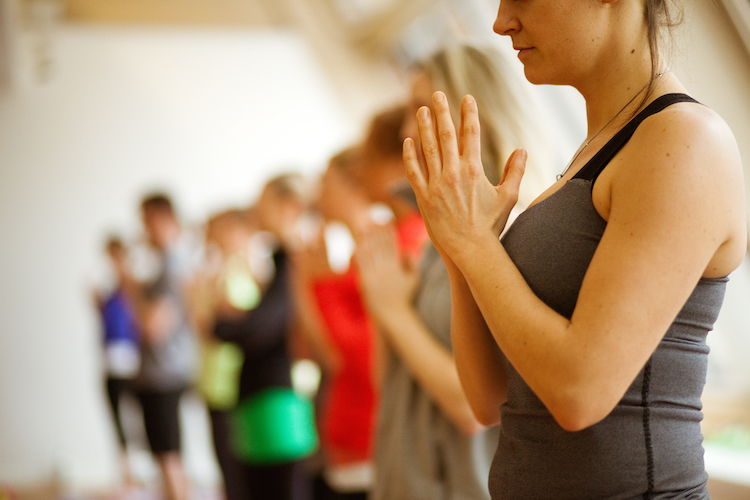
Like many people, I first got into yoga to “get a good stretch.”
In some ways that made total sense—when it comes to increasing flexibility, yoga can’t be beat.
From the balance of stretching and strength building, to the steady movements paired with steady breathing, yoga has the potential to transform us from the inside out.
But the key word here is “potential.” If we’re not careful, if we don’t pay attention to the classes we’re taking, the attitudes of our teachers, and (most importantly) our attitudes toward ourselves and our own practice, we can do yoga incorrectly. And improper yoga can actually lead to a decrease in flexibility—mental flexibility.
When I first started yoga, I could barely touch my toes. However, as I slowly gained a little more mobility in my body, I lost a little of that mobility in my brain. It didn’t matter whether the teacher treated their class like an episode of America’s Got Talent or if the teacher had been exceptionally conscious of demonstrating modifications; I would come to class, unroll my mat, and muscle into what I thought were “legitimate” yoga poses.
Even as my practice grew stronger, I remained unsatisfied. I would look to the next expression of the poses—the more advanced versions of the practice—and wish I could already do them. I would attempt to laugh it off at first, innocently shrugging at my inability to float into certain poses, facetiously noting those who must have been acrobats in a previous life.
But even in a comical light, it didn’t change the effect it had on my mind. I would go through an entire class thinking things like, “If I could only get my hips to do this,” “if I could only make my arms do that,” “if I could only look more like the lady over there when I do yoga.”
Without even noticing it, I had made a value judgment on the various physical levels of yoga and berated myself for not being at the top.
We’ve all been there. It’s easy to fall into that trap. We could be in the most inclusive class with the most accepting teacher and still grimace at ourselves as we wobble around in a balancing pose. We start to wedge and ratchet our elbow into a new position during a twist because we feel like there is something more to be gained if we get “deeper” into the twist—even if it’s forced. This feeling is only magnified when we walk into a class and there is already an air of competition in the room.
It took a string of injuries before I finally let go of my ego and did what suited me best.
It took having no choice but to go gentle before I let go of comparing myself with the yogis in magazines and on the web.
I became content with what my body could do at that present moment.
However, I was not out of the woods. Once I let go of what I thought my body should be able to do, once I started subscribing to the more spiritual aspect of yoga, my mental inflexibility shifted to include an immovable attitude on how my mind should feel.
I had a very specific idea of how calm or centered I should feel for every single class—anything less was a failure. I would take a class with a new teacher and become irritated with how much she chatted or joked. I would become fixated on the coughing student, the traffic outside, anything that was taking away from my “experience.” I’d bemoan an unsatisfactory practice the way I would bemoan an unattainable pose.
Ironically, I would sometimes find myself in savasana going, “I’m not experiencing Zen right now. I am so annoyed.”
It is far too easy to categorize what we see or feel in yoga. We label yoga practices “good” or “bad” based on how well we are able to flow, or how grounded or ethereal we feel. We set up unshakable expectations of how our practice should go and become disappointed when we do not reach them.
I once heard a yoga instructor talk about people with enough bendy-stretchy abilities that they could have joined Cirque du Soleil, but with a mindset that was as rigid and immobile as a two-by-four piece of solid oak.
Yoga is as much for the mind as it is for the spirit and the body. This means we need to allow our brains to be flexible.
It means accepting our abilities and limits without judgment. It means accepting that sometimes a class will be silly, sometimes we’ll completely lose our breath, or sometimes we’ll be preoccupied with our to-do lists. It means recognizing that we are exactly where we need to be at that given moment, whether it’s in a modified pose or an accidental nap during savasana.
There’s a common saying in yoga: “Yoga without breathing is just calisthenics.” I’d go one step further and say, “Yoga without acceptance is just a set-up for injury and disappointment.”
So maybe we’re doing the fullest expression of the pose. Maybe we’re not. Maybe we’re clearing out our chakras like a janitor on the loose during class. Maybe we’re spending the entire class holding in a fart. Where the experience falls on the map is irrelevant, so long as we’re on the map in the first place.
Let’s look around ourselves—at the class, at the video on the laptop or T.V. screen, at the teacher leading the sequence—and especially at ourselves. Is there anything going on that is making us lock up our brains, making us feel like we must do A, B, and C, or else our practice isn’t legitimate?
It might be time to see if we can let go of more than just the tension in our bodies as we go into our forward fold.
~ Abby Rosmarin
Love elephant and want to go steady?
Sign up for our (curated) daily and weekly newsletters!
Apprentice Editor: Guenevere Neufeld / Editor: Catherine Monkman
Photo: wiki commons






Read 0 comments and reply